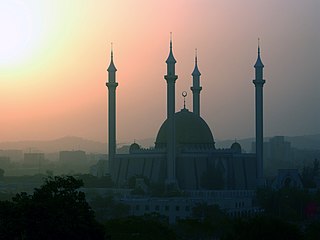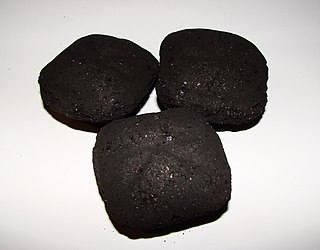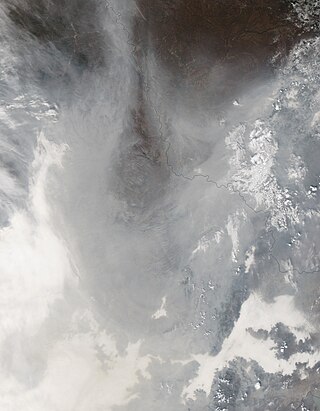
Smog, or smoke fog, is a type of intense air pollution. The word "smog" was coined in the early 20th century, and is a portmanteau of the words smoke and fog to refer to smoky fog due to its opacity, and odor. The word was then intended to refer to what was sometimes known as pea soup fog, a familiar and serious problem in London from the 19th century to the mid-20th century, where it was commonly known as a London particular or London fog. This kind of visible air pollution is composed of nitrogen oxides, sulfur oxide, ozone, smoke and other particulates. Man-made smog is derived from coal combustion emissions, vehicular emissions, industrial emissions, forest and agricultural fires and photochemical reactions of these emissions.

The Great Smog of London, or Great Smog of 1952, was a severe air pollution event that affected London, England, in December 1952. A period of unusually cold weather, combined with an anticyclone and windless conditions, collected airborne pollutants—mostly arising from the use of coal—to form a thick layer of smog over the city. It lasted from Friday 5 December to Tuesday 9 December 1952, then dispersed quickly when the weather changed.

Haze is traditionally an atmospheric phenomenon in which dust, smoke, and other dry particulates suspended in air obscure visibility and the clarity of the sky. The World Meteorological Organization manual of codes includes a classification of particulates causing horizontal obscuration into categories of fog, ice fog, steam fog, mist, haze, smoke, volcanic ash, dust, sand, and snow. Sources for particles that cause haze include farming, traffic, industry, windy weather, volcanic activity and wildfires. Seen from afar and depending on the direction of view with respect to the Sun, haze may appear brownish or bluish, while mist tends to be bluish grey instead. Whereas haze often is considered a phenomenon occurring in dry air, mist formation is a phenomenon in saturated, humid air. However, haze particles may act as condensation nuclei that leads to the subsequent vapor condensation and formation of mist droplets; such forms of haze are known as "wet haze".

The Clean Air Act 1956 was an Act of the Parliament of the United Kingdom enacted principally in response to London's Great Smog of 1952. It was sponsored by the Ministry of Housing and Local Government in England and the Department of Health for Scotland, and was in effect until 1993.
Raymond Tucker was an American politician that served as the 38th mayor of St. Louis from 1953 until 1965.

Bernard Francis Dickmann was the 34th mayor of St. Louis from 1933 to 1941.

The Air Pollution Control Act of 1955 was the first U.S. federal law to address the national environmental problem of air pollution. This was "an act to provide research and technical assistance relating to air pollution control". The act "left states principally in charge of prevention and control of air pollution at the source". The act declared that air pollution was a danger to public health and welfare, but preserved the "primary responsibilities and rights of the states and local government in controlling air pollution".

Smokeless fuel is a type of solid fuel which either does not emit visible smoke or emits minimal amounts during combustion. These types of fuel find use where the use of fuels which produce smoke, such as coal and unseasoned or wet wood, is prohibited.

The 1948 Donora smog killed 20 people and caused respiratory problems for 6,000 of the 14,000 people living in Donora, Pennsylvania, a mill town on the Monongahela River 24 miles (39 km) southeast of Pittsburgh. The event is commemorated by the Donora Smog Museum.

Pea soup fog is a very thick and often yellowish, greenish or blackish fog caused by air pollution that contains soot particulates and the poisonous gas sulphur dioxide. This very thick smog occurs in cities and is derived from the smoke given off by the burning of soft coal for home heating and in industrial processes. Smog of this intensity is often lethal to vulnerable people such as the elderly, the very young (infants) and those with respiratory problems. The result of these phenomena was commonly known as a London particular or London fog; in a reversal of the idiom, "London particular" became the name for a thick pea and ham soup.

Air pollution in the United Kingdom has long been considered a significant health issue, and it causes numerous other environmental problems such as damage to buildings, forests, and crops. Many areas, including major cities like London, are found to be significantly and regularly above legal and recommended pollution levels. Air pollution in the UK is a major cause of diseases such as asthma, lung disease, stroke, cancer, and heart disease, and is estimated to cause forty thousand premature deaths each year, which is about 8.3% of deaths, while costing around £40 billion each year.
Prairie State Energy Campus is a 1,600 megawatt base load, coal-fired, electrical power station and coal mine near Marissa, Illinois, southeast of St. Louis, Missouri. Prairie State Energy Campus (PSEC) features low levels of regulated emissions compared to other coal-fired power stations, capturing sulfur from high-sulfur coal mined nearby instead of transporting low-sulfur coal from elsewhere.
The history of St. Louis, Missouri, from 1905 to 1980 saw declines in population and economic basis, particularly after World War II. Although St. Louis made civic improvements in the 1920s and enacted pollution controls in the 1930s, suburban growth accelerated and the city population fell dramatically from the 1950s to the 1980s. Like many urban areas, St. Louis experienced high unemployment during the Great Depression, then expanded its industrial base during World War II. The city became home to Gateway Arch National Park during the 1930s, and during the 1960s the Gateway Arch was built on the memorial grounds. St. Louis City and St. Louis County made multiple attempts at consolidation during the period, but none were particularly successful. Despite attempts at urban renewal that included public housing projects such as the Pruitt-Igoe complex, the city continued to lose population to county cities.

A dense wave of smog began in Northeast China, especially in major cities including Harbin, Changchun and Shenyang, as well as the surrounding Heilongjiang, Jilin, and Liaoning provinces on 20 October 2013. Unseasonably warm temperatures with very little wind across northeastern China coincided with the initiation of Northeast China's coal-powered municipal heating system. Record densities of fine particulates were measured in the city.

The 2013 Eastern China smog was a severe air pollution episode that affected East China, including all or parts of the municipalities of Shanghai and Tianjin, and the provinces of Hebei, Shandong, Jiangsu, Anhui, Henan, and Zhejiang, during December 2013. A lack of cold air flow, combined with slow-moving air masses carrying industrial emissions, collected airborne pollutants to form a thick layer of smog over the region. Levels of PM2.5 particulate matter averaged over 150 micrograms per cubic metre; in some areas, they were 300 to 500 micrograms per cubic metre.

Rolling coal is the practice of modifying a diesel engine to deliberately emit large amounts of black or grey diesel exhaust, containing soot and incompletely combusted diesel. Rolling coal is used as a form of anti-environmentalism protest. In most jurisdictions it is illegal, due to violating clean air laws, and also reduces the fuel economy of the vehicle.

APEC blue refers to the rare blue sky in Beijing during APEC China 2014 due to emission reduction campaign directed by Chinese government. Because of its transience, the new phrase "APEC blue" also refers to something wonderful but also fleeting.

The 1966 New York City smog was a major air-pollution episode and environmental disaster, coinciding with that year's Thanksgiving holiday weekend. Smog covered the city and its surrounding area from November 23 to 26, filling the city's air with damaging levels of several toxic pollutants. It was the third major smog in New York City, following events of similar scale in 1953 and 1963.
Environmental issues in Toronto encompasses all those concerns and opportunities presented by the environment of Toronto. Many are harmful effects, such as the pollution of air and water, while others are factors influenced by urban infrastructures such as highways and public transportation services. As a result of the city's large population, substantial waste is produced annually.
The 1962 London smog was a severe smog episode that affected London, England, in December 1962. It occurred ten years after the Great Smog of London, in which serious air pollution had killed as many as 12,000 people. While the 1952 smog had led to the passing of the 1956 Clean Air Act, which restricted the burning of domestic fuels in urban areas with the introduction of smokeless zones, fogs continued to be smoky in London for some years after the act as residents and operators were given time to convert from domestic fuels. The December 1962 smog is thought to have led to the deaths of up to 700 people.















